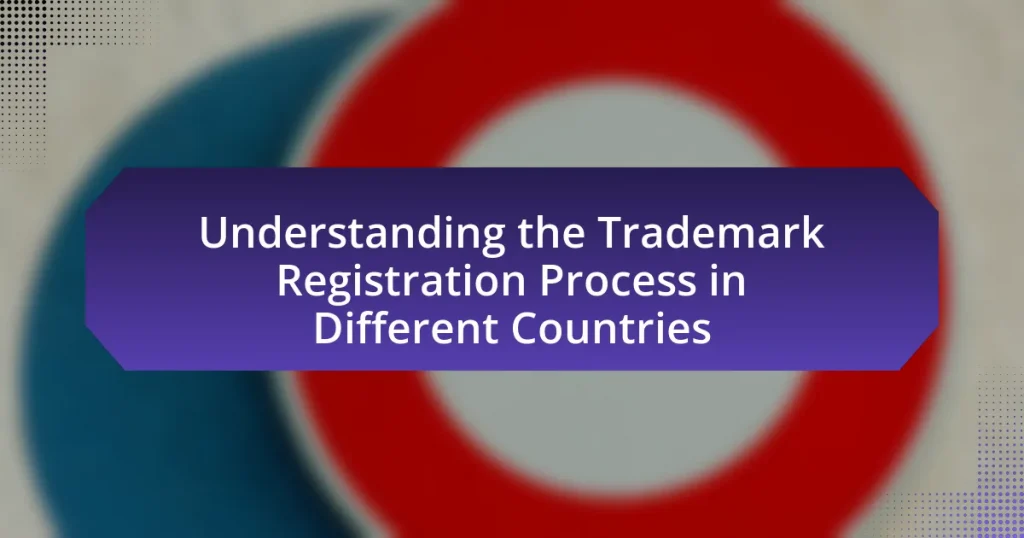Trademark searches are a critical step before filing a trademark application, as they help identify existing trademarks that may conflict with a new mark. Conducting a thorough search mitigates the risks of legal disputes, financial losses, and damage to brand reputation, with statistics indicating that over 50% of trademark applications are rejected due to conflicts. The article outlines the risks associated with not performing a trademark search, the legal consequences of trademark infringement, and the best practices for conducting comprehensive searches. It emphasizes the importance of utilizing various resources, including online databases and professional services, to ensure a unique and protectable brand identity.

Why are Trademark Searches Important Before Filing?
Trademark searches are important before filing because they help identify existing trademarks that may conflict with a new application. Conducting a thorough search reduces the risk of legal disputes and potential rejection by the trademark office. According to the United States Patent and Trademark Office, approximately 50% of trademark applications are rejected due to conflicts with existing marks. This statistic underscores the necessity of performing a trademark search to ensure that a proposed mark is unique and does not infringe on others, thereby protecting the applicant’s investment and brand identity.
What risks are associated with not conducting a trademark search?
Not conducting a trademark search poses significant risks, including the potential for legal disputes, financial losses, and brand reputation damage. Without a thorough search, a business may unknowingly infringe on an existing trademark, leading to lawsuits that can result in costly legal fees and damages. According to the United States Patent and Trademark Office, trademark infringement can lead to the loss of the right to use a brand name, forcing a company to rebrand and incur additional expenses. Furthermore, failing to identify conflicting trademarks can harm a company’s reputation if consumers associate the brand with legal issues or confusion in the marketplace.
How can trademark infringement affect a business?
Trademark infringement can significantly harm a business by leading to legal disputes, financial losses, and damage to brand reputation. When a business’s trademark is infringed, it may face costly litigation to protect its intellectual property, which can divert resources and attention from core operations. Additionally, if the infringing party is found to have caused confusion among consumers, the original business may suffer a decline in sales and customer trust. According to the International Trademark Association, businesses can lose up to 20% of their revenue due to trademark infringement, highlighting the financial impact. Furthermore, ongoing infringement can dilute a brand’s identity, making it harder for consumers to distinguish the original products from counterfeit or inferior alternatives.
What legal consequences can arise from failing to search?
Failing to conduct a trademark search before filing can lead to significant legal consequences, including the risk of trademark infringement lawsuits. When a business does not verify existing trademarks, it may inadvertently use a mark that is already registered, resulting in legal actions from the rightful owner. Such lawsuits can lead to costly damages, including monetary compensation for losses incurred by the trademark owner and potential injunctions that prohibit the use of the infringing mark. Additionally, the infringing party may face reputational harm and increased legal fees associated with defending against the claims. According to the United States Patent and Trademark Office, over 50% of trademark applications are rejected due to conflicts with existing marks, underscoring the importance of thorough searches to avoid these legal pitfalls.
How do trademark searches contribute to brand protection?
Trademark searches contribute to brand protection by identifying existing trademarks that may conflict with a new brand. Conducting a thorough search helps businesses avoid potential legal disputes and infringement claims, which can lead to costly litigation and damage to reputation. According to the United States Patent and Trademark Office, over 1.5 million trademark applications were filed in 2020, highlighting the competitive nature of brand registration. By ensuring that a proposed trademark is unique and not already in use, companies can secure their brand identity and maintain their market position effectively.
What role does a trademark search play in establishing brand identity?
A trademark search is essential in establishing brand identity as it helps identify existing trademarks that may conflict with a new brand. By conducting a thorough search, businesses can avoid potential legal disputes and ensure that their brand name, logo, or slogan is unique and protectable. This process not only safeguards the brand’s identity but also enhances its marketability, as a distinctive trademark can lead to stronger consumer recognition and loyalty. According to the United States Patent and Trademark Office, over 1.5 million trademarks were registered in 2020, highlighting the competitive landscape where a comprehensive search is crucial for differentiation and brand establishment.
How can a trademark search help in avoiding market confusion?
A trademark search helps in avoiding market confusion by identifying existing trademarks that may be similar or identical to a proposed mark. This proactive measure allows businesses to assess the risk of potential legal disputes and consumer confusion before launching a product or service. According to the United States Patent and Trademark Office, conducting a thorough trademark search can reveal registered and pending trademarks, enabling companies to make informed decisions about their branding strategies and avoid costly rebranding efforts or litigation.

What are the steps involved in conducting a trademark search?
The steps involved in conducting a trademark search include identifying the relevant trademarks, searching databases, analyzing search results, and documenting findings. First, one must identify the trademarks that are relevant to the goods or services intended for registration. Next, searching databases such as the United States Patent and Trademark Office (USPTO) database or other international trademark databases is essential to find existing trademarks that may conflict. After obtaining search results, analyzing them for similarities in name, design, and goods or services is crucial to assess potential conflicts. Finally, documenting the findings provides a clear record of the search process and results, which is important for future reference and legal considerations.
How can businesses perform a preliminary trademark search?
Businesses can perform a preliminary trademark search by utilizing online databases and resources to identify existing trademarks that may conflict with their intended mark. The United States Patent and Trademark Office (USPTO) provides a searchable database called the Trademark Electronic Search System (TESS), which allows users to check for registered trademarks. Additionally, businesses can search state trademark databases and conduct general internet searches to uncover unregistered trademarks. This process helps businesses assess the availability of their desired trademark and reduces the risk of potential legal disputes.
What resources are available for conducting a trademark search?
The primary resources available for conducting a trademark search include the United States Patent and Trademark Office (USPTO) database, state trademark databases, and commercial trademark search services. The USPTO database provides access to registered trademarks and pending applications, allowing users to search for existing trademarks that may conflict with their own. State trademark databases offer similar information at the state level, which can be crucial for local businesses. Additionally, commercial trademark search services, such as TrademarkNow and Corsearch, provide comprehensive search tools and analysis, often including international trademarks and common law usage, enhancing the thoroughness of the search process. These resources collectively ensure that individuals and businesses can effectively identify potential trademark conflicts before filing.
How can online databases assist in the search process?
Online databases assist in the search process by providing comprehensive access to trademark records, which enables users to identify existing trademarks and assess potential conflicts before filing. These databases, such as the United States Patent and Trademark Office’s Trademark Electronic Search System (TESS), contain millions of registered trademarks, allowing users to conduct thorough searches using various criteria like name, owner, and class of goods. The availability of these resources significantly reduces the risk of trademark infringement and enhances the likelihood of successful registration, as evidenced by the fact that approximately 50% of trademark applications are rejected due to conflicts with existing marks.
What should be included in a comprehensive trademark search?
A comprehensive trademark search should include an examination of existing trademarks in relevant databases, including the United States Patent and Trademark Office (USPTO) database, state trademark registries, and common law sources. This search identifies potential conflicts with registered or pending trademarks that could impede the registration of a new mark. Additionally, it should encompass a review of similar marks in related industries to assess the likelihood of confusion among consumers. Conducting a thorough search helps to mitigate legal risks and informs strategic decisions regarding trademark registration.
How do common law trademarks factor into the search?
Common law trademarks significantly influence trademark searches by establishing rights based on actual use in commerce rather than registration. These trademarks can create enforceable rights that may not be reflected in official databases, making it essential for businesses to consider them during searches. For instance, a business using a mark in a specific geographic area may have common law rights to that mark, even if it is not registered, which could lead to potential conflicts if another entity attempts to register a similar mark. Therefore, thorough searches must include common law sources, such as business directories and online platforms, to identify any unregistered trademarks that could pose legal challenges.
What is the significance of searching international trademarks?
Searching international trademarks is significant because it helps businesses identify potential conflicts with existing trademarks in global markets. This proactive approach minimizes the risk of legal disputes, which can lead to costly litigation and brand damage. According to the World Intellectual Property Organization, over 1.5 million trademark applications were filed globally in 2020, highlighting the competitive landscape. By conducting thorough searches, companies can ensure their trademarks are unique and protectable, thereby enhancing their brand’s value and market position.

What are the best practices for trademark searches before filing?
The best practices for trademark searches before filing include conducting comprehensive searches across multiple databases, including the United States Patent and Trademark Office (USPTO) database, state trademark databases, and international trademark databases if applicable. This thorough approach helps identify existing trademarks that may conflict with the proposed mark. Additionally, utilizing professional trademark search services can enhance the accuracy of the search results, as these services often have access to proprietary databases and tools that provide deeper insights. It is also advisable to search for similar marks in related industries, as this can reveal potential conflicts that may not be immediately apparent. Finally, documenting the search process and findings is crucial for establishing due diligence, which can be beneficial in case of future disputes.
How often should businesses conduct trademark searches?
Businesses should conduct trademark searches at least annually and whenever they plan to launch a new product or service. Regular searches help identify potential conflicts with existing trademarks, reducing the risk of legal disputes. According to the United States Patent and Trademark Office (USPTO), conducting thorough searches before filing can prevent costly litigation and ensure that a business’s brand remains protected.
What triggers the need for a new trademark search?
A new trademark search is triggered by significant changes in business circumstances, such as the introduction of a new product line, expansion into new markets, or a change in ownership. These changes can increase the risk of potential conflicts with existing trademarks. For instance, if a company plans to launch a product that is similar to one already trademarked, a new search is essential to identify any potential infringement issues. Additionally, updates in trademark laws or databases may necessitate a fresh search to ensure compliance and protection.
How can businesses stay updated on trademark registrations?
Businesses can stay updated on trademark registrations by regularly monitoring the United States Patent and Trademark Office (USPTO) database and subscribing to trademark watch services. The USPTO provides a searchable online database where businesses can check for new trademark applications and registrations, ensuring they are aware of any potential conflicts. Additionally, trademark watch services offer alerts for new filings that may be similar to a business’s existing trademarks, helping to protect their intellectual property. These methods are essential for maintaining awareness of the trademark landscape and avoiding infringement issues.
What tips can help ensure a successful trademark search?
To ensure a successful trademark search, conduct a comprehensive search across multiple databases, including the United States Patent and Trademark Office (USPTO) database, state trademark databases, and international databases if applicable. This thorough approach helps identify existing trademarks that may conflict with your desired mark. Additionally, utilize variations of your trademark, including synonyms and phonetic equivalents, to capture potential conflicts that may not be immediately obvious. Engaging a trademark attorney can also provide expert insights and help navigate complex legal nuances, increasing the likelihood of a successful search.
How can engaging a trademark attorney enhance the search process?
Engaging a trademark attorney enhances the search process by providing expert knowledge and experience in identifying potential conflicts with existing trademarks. Trademark attorneys utilize specialized databases and tools that may not be accessible to the general public, allowing for a more thorough and comprehensive search. Their understanding of trademark law enables them to interpret search results accurately, assessing the likelihood of confusion with similar marks. Additionally, trademark attorneys can advise on the nuances of trademark classes and jurisdictions, ensuring that the search covers all relevant areas. This expertise significantly reduces the risk of costly legal disputes and increases the chances of successful trademark registration.
What common mistakes should be avoided during a trademark search?
Common mistakes to avoid during a trademark search include failing to conduct a comprehensive search, relying solely on exact matches, and neglecting to check variations and similar marks. A comprehensive search is crucial because it helps identify potential conflicts with existing trademarks, which can lead to legal disputes. Relying only on exact matches can overlook similar trademarks that may cause confusion among consumers. Additionally, neglecting variations, such as different spellings or phonetic similarities, can result in overlooking potential conflicts. These mistakes can significantly impact the success of a trademark application and the brand’s long-term viability.



